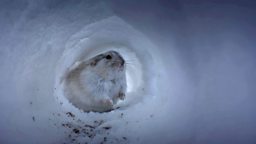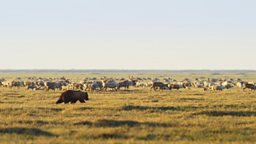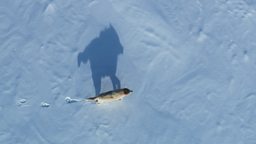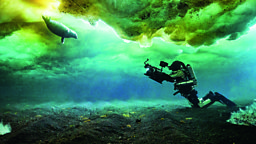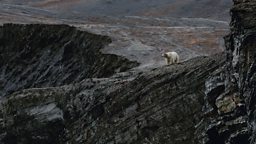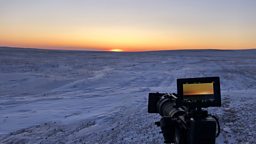Filming puma in the dark of night
By Helen Hobin, camerawoman for Frozen Planet II
It's like filming on the moon or underwater
On location in Patagonia, Chile, our guide Diego Araya summed up the absolute strangeness of shooting in the dark - "It's like filming on the moon or underwater - a totally different world, an alien landscape."

an extraordinary insight into events taking place in the pitch-black landscape
We had travelled out to the Estancia Laguna Amarga, a private ranch bordering the Torres del Paine National Park, in an attempt to film pumas hunting at night. To do this, we were using thermal technology - cameras designed more for scientific or military use than for the field. They were cumbersome and temperamental but gave us an extraordinary insight into events taking place in the pitch-black landscape. Dawson Dunning, a brilliant American cinematographer, had filmed pumas on several occasions, but doing so with thermal cameras was a first even for him. For director Joe Treddenick and I, it was an utterly new experience.
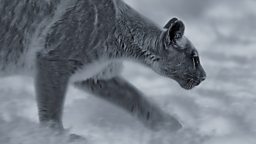
The winds were so strong and relentless
Each day, we would set out around dusk to begin the search for the well-camouflaged cats, with trackers Roberto and Rodrigo also traversing the undulating landscape. The winds were so strong and relentless that it became second nature to regularly turn your back to the gusts and nestle your walkie-talkie deep inside your coat - otherwise, you'd have little hope of hearing the faint exclamation: "Cat!"
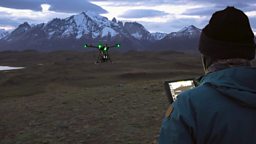
like watching a game of grandmother's footsteps
I would launch a thermal drone to help us locate and keep track of the rapidly moving pumas as they attempted to stalk and ambush their prey - large llama-like creatures called guanaco. Whilst the pumas have incredible night vision, the guanaco are always on high alert, and stay together in close herds to keep watch. They are particularly skittish in the dark. Seeing a hunt unfold is like watching a game of grandmother's footsteps, and you might spend hours watching a puma slowly inch closer. But if just one guanaco spots a cat, they let out a distinctive alarm call, immediately meaning game over. On several nights we saw a young, inexperienced puma blunder at the pivotal moment of the ambush, too indecisive about which way to run when the herd split.
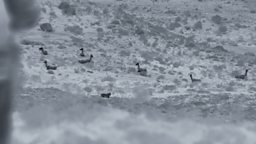
Some nights we would spend hours hiking in the howling wind and pouring rain
Some nights we would spend hours hiking in the howling wind and pouring rain, without ever glimpsing so much as a tail. Trekking up and down hills with kit can be intense but doing so in the dark whilst trying to keep pace with a big cat was on a completely new level. On one occasion I spent 8 hours with Claudio - another of our wonderful Chilean guides - simply lying flat and staring through our thermal scopes at some distant bushes, which we'd seen a puma enter. She didn't decide to emerge and given the cold; we couldn't blame her!

all you encounter is a strange screen-blindness as you blink into the dark
The thermal cameras allowed us to scan the landscape quickly, looking for heat signatures. If we spotted something moving, we'd watch the animal's gait intently, waiting to see if a fox had gotten our hopes up again. When our luck was in and we began actually filming, it was easy to fall into the usual long lens habit of glancing up to check where our subject was heading. But in the darkness of night, the monitor screen of the thermal camera is your only insight into the events unfolding - peripheral vision doesn't exist - and if you glance away from the screen, all you encounter is a strange screen-blindness as you blink into the dark. I learnt the hard way that it was not a good idea to place any item on the ground during a night shoot - you only had to take a few disoriented steps away for that pair of gloves to vanish in the dark.
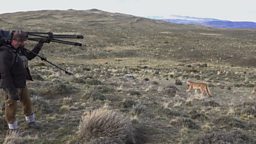
a confusing end-of-day breakfast and an attempt at sleep
It was eerie sometimes to have the privileged insight of thermal vision – we watched hunting pumas and wary guanacos move within metres of each other unknowingly, the roaring wind diminishing their hearing. It might sound frightening to be moving around in the dark, on foot, near hunting big cats, but when a puma casually appeared and strolled past us one evening just beyond dusk, it did so with an amazing indifference - as if we weren't even present. Having become so invested in their efforts, we’d feel the gravity of another night for them with an empty belly. And we'd return to our lodging as the sun rose, for a confusing end-of-day breakfast and an attempt at sleep.
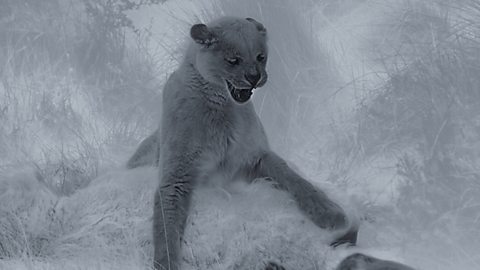
An encounter between two solitary pumas
A young female puma attempts to share a kill made by an older female.
